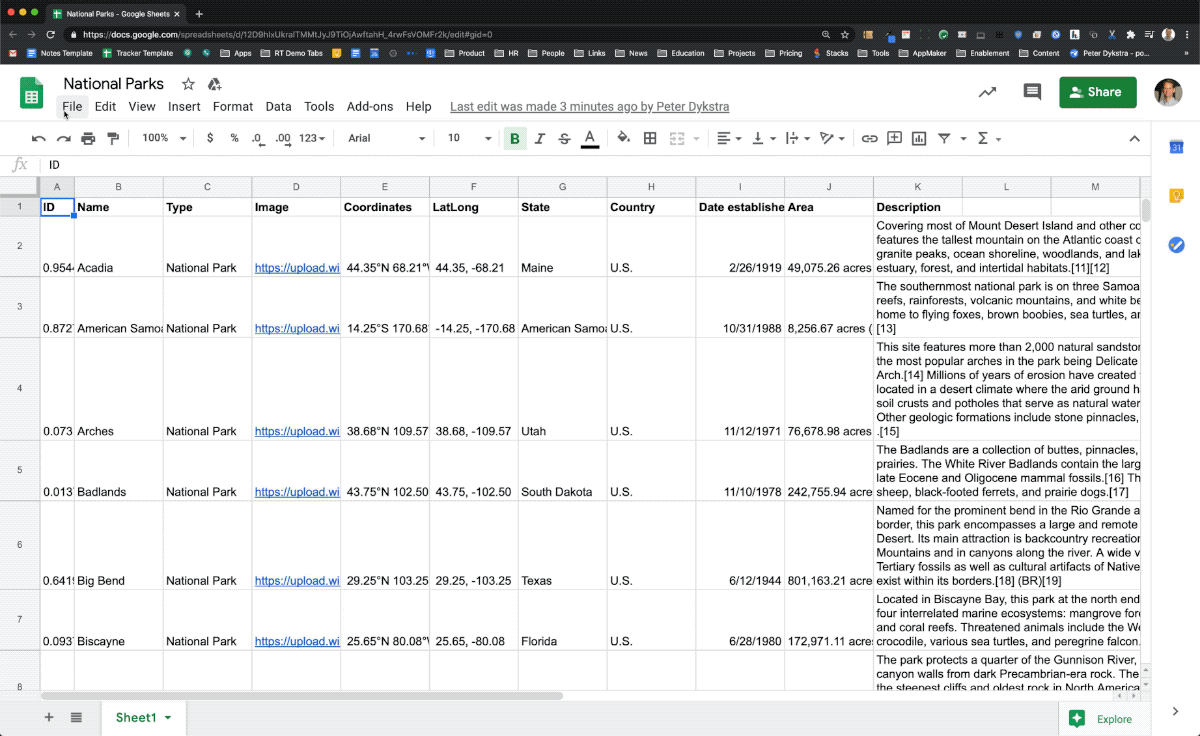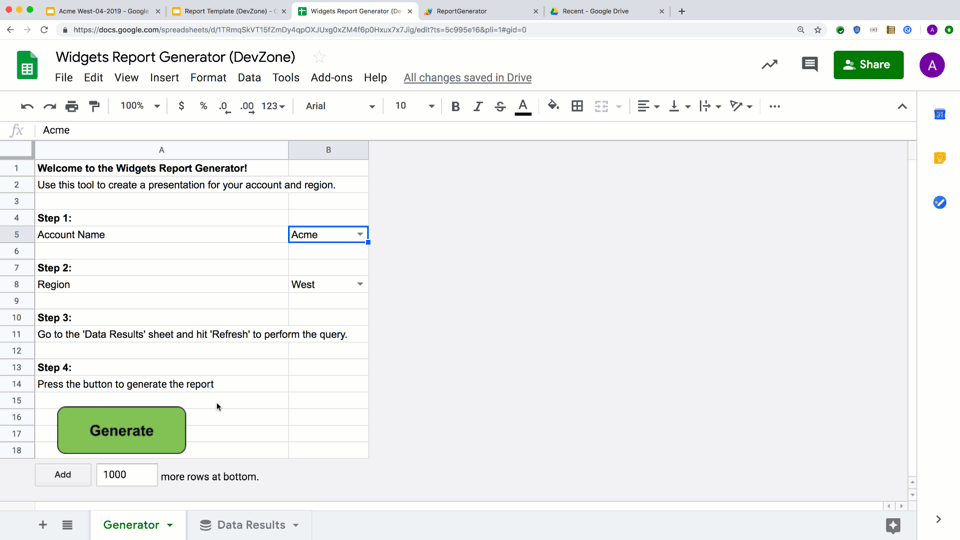AppSheet and Apps Script empower Google Workspace users to build solutions they need
We recently announced Google Workspace, which seamlessly brings together messaging, meetings, docs, and tasks to help our customers create, communicate, and collaborate even more effectively. This includes the ability to extend and customize productivity in ways beyond Google Workspace, through AppSheet, Google Cloud’s no-code development platform, and Apps Script, Google Workspace’s integrated low-code development platform.
The power of these platforms comes from their ability to let anyone—even people without coding backgrounds—customize their work. Whether that means building an app that your field team can use to track customer visits, a custom function in Sheets that performs a specific calculation, or even a macro that automates a repetitive task, with AppSheet and Apps Script, you can create these types of custom solutions more easily than ever.
AppSheet and Apps Script empower users to extend the power of Google Workspace by building business apps, workflows, and automations. AppSheet lets you build custom applications on top of Google Workspace applications, as well as all other services and applications in your environment, all without writing any code. Meanwhile, with just a few lines of code, Apps Script lets you extend and modify the behavior of Google Workspace applications with customizations like Sheet functions, menu items, triggers, data validation, and more.
How no-code extends Google Workspace
As a true no-code platform, AppSheet requires no coding experience to create and deploy an app or workflow, including those that leverage your favorite Google Workspace applications. Everything can be done using AppSheet’s UI, which includes natural language capabilities powered by machine learning as well as expressions that translate complex code into user-friendly forms, similar to Sheets formulas. Common use cases include field service and data capture, transportation logistics, compliance reporting, delivery tracking, facilitation of property surveys, and much more.
AppSheet applications allow you to harness a broad range of data sources and functions. From data captured in custom applications and SQL databases to other sources including Google Maps and Google Workspace applications like Sheets, Drive, Docs, Calendar, and Meet,, AppSheet offers a myriad of possibilities for creating business solutions and improving workflows. AppSheet applications are deployed as mobile and web apps and are therefore supported by your favorite browser, whether it be on your desktop, iOS or Android platforms, giving your teams the flexibility to use their everyday work devices.

How low-code customizes Google Workspace
Apps Script is a low-code development platform, included with Google Workspace, that makes it fast and easy to build custom business solutions that integrate with, automate processes within, and extend your favorite apps like Gmail, Docs, Sheets, and Drive. Apps Script uses the scripting language JavaScript and natively integrates it with Google Workspace APIs and events, helping you build custom business solutions, from menus to macros and automations—all so that you can simplify your day-to-day routines.
Apps Script is designed to meet you where you’re already working, so you can hit the ground running without complication. It lives completely in the cloud, in Google Drive. Nothing to download or configure, and no servers or infrastructure to maintain. If you don’t have much coding experience, you might be hesitant, but Apps Script was built with the business user in mind and has removed a lot of complexity, making it easier to get started. With support resources ranging from example solutions and scripts shared by users in forums to online tutorials, developers and non-technical users alike can use Apps Script to quickly and easily build solutions that customize and automate Google Workspace.
In some cases, automating a solution might be as simple as copying and pasting a few lines of code. And if you already have any experience with JavaScript, Apps Script makes it easy to do more with and expand your skills.

Do more with Google Workspace: using AppSheet, Apps Script, or both
With Apps Script you can extend and modify Google Workspace applications with custom logic. And with AppSheet you can build custom applications and business automations atop Google Workspace and other services and applications. It’s never been easier to create novel solutions to pressing business needs, whether that means a simple script to speed up a small process or a sophisticated app or automation to redefine entire line-of-business workflows. Apps Script and AppSheet are powerful on their own, and because they complement each other, using them together can be even more impactful.
We’ve seen a number of companies significantly reduce product backlogs because citizen development enables the creation of many apps that IT couldn’t get to. Citizen developers want to build solutions and often, all they need is to be given the no-code and low-code tools to do it. Moreover, both AppSheet and Apps Script can be used by traditional IT, in addition to citizen developers, to speed up workflows or achieve some tasks more easily. Both solutions also provide IT with the tools it needs to maintain appropriate visibility and governance in the app- creation process.
But you may be wondering when to use which platform, and how they interact together. To decide when to use these platforms for given use cases, we suggest you consider the following:
What tools are you familiar with?
What do you want to achieve?
How complicated is the problem you’re trying to solve?
Below, we present some use cases to help you assess how you can best leverage AppSheet and Apps Script to build certain solutions.
“I want to build an application with an intuitive user interface that leverages my Google Workspace data and can be used by either a laptop or mobile device.”
If this sounds like your use case, we recommend AppSheet, as it generates a clean, responsive, and intuitive UI for any device.
“I want to build a solution that allows me to interact with several Google Workspace applications like Gmail, Sheets, and Docs.”
Both products can help you accomplish this, so let’s get a little more specific.
If you need an app that leverages Google Workspace, AppSheet is a great option because it lets users pull data and functionality from different Google Workspace products into a user-friendly application. Let’s say you need to create an inventory management solution. You could create an AppSheet app that reads and updates a Google Sheet full of your inventory data, then triggers an email and text notification when inventory levels get low. AppSheet also offers barcode, NFC and QR scanning, and machine learning capabilities like optical character recognition and data anomaly detection—all capabilities that could make an inventory management app even more powerful.
Now let’s say you wanted to build a solution that triggers an event in one Google Workspace app based on an action in another. Both platforms may work for this, depending on the action. Apps Script provides a robust catalog of services for each Google Workspace app that allow you to set up workflows and automations that can trigger an action in one app, such as creating a new Drive folder or sending an email, based on an action in another. You could also build such a workflow in AppSheet, which doesn’t provide as extensive a catalog of services as Apps Script does but can still handle many common use cases. So which one do you use? It all depends on which platform you are familiar with, how much control over the customization you want, and whether or not you want to use code.
“I’d like to use third-party data sources.”
This is another case where both platforms may work. AppSheet can connect to a wide variety of data sources, including SQL databases and third-party APIs. But if you’re trying to not only pull that data into Sheets or other Google Workspace applications, but also clean and customize it, Apps Script makes more sense.
“I want to create a custom calculation in Sheets.”
Google Sheets offers hundreds of built-in functions like AVERAGE, SUM, and COUNT. When these aren’t enough for your needs, you can use Apps Script to write custom functions—such as converting meters to miles or fetching live content from the Internet—then use them in Google Sheets just like a built-in function.
“I want to create an automation that uses information from a Google Forms submission, then automatically sends a response email and makes submissions a menu item in Sheets.”
One of Apps Script’s powerful features is creating automations that use custom menus, which ensures information is easily accessible where and when you need it. When you create a custom menu in Sheets, it appears in your Google Workspace application as an option on your toolbar. This makes it possible to run a script in Apps Script as easily as clicking File > Print. Apps Script allows for extensive customization, but AppSheet can also be a powerful resource for this use case, as it includes many business automation capabilities out-of-box that can be built via an intuitive, natural language-based interface.
Even more powerful together
Whereas in some cases, AppSheet or Apps Script may be more appropriate, in others, the two solutions can work together to help you do even more, as the following examples attest.
“I want to gather and format information from multiple sources and create an app to interact with it.”
With Apps Script you can pull information from multiple sources—such as Docs, Sheets, Calendar and third-party APIs—then automate the aggregation of the information into a Sheet and manipulate the information with scripts as you require. You can then build an AppSheet app on top of that data, allowing you to interact with it through your own custom UI.
“I want to build an app that my team can interact with that triggers complex workflows when certain actions occur.”
You can build an app in AppSheet that can trigger workflows built in either AppSheet or Apps Script. Depending on the action you want, either platform may work. For those who already have Apps Script workflows set up within Google Workspace, you can easily build an app with AppSheet to help you manage how and when your workflows are triggered. For those that have already built an Apps Script web app, you might want to try to build it with AppSheet for better management and maintenance.
“I want to have a modern and easily manageable app that also serves as a front end to complex workflows.”
This is a great use case where both AppSheet and Apps Script can be used together. AppSheet can be used to build an app on top of a Sheet that collects needed data from triggers built in Apps Script. Triggers let Apps Script run a service automatically on a certain event, like when someone opens or edits a Google Docs, Sheets, Slides, or Forms file. In addition to triggers, Apps Script can be used to create a variety of workflows in the background that are monitored and visible by an app built in AppSheet.
Wrap up and takeaways
AppSheet and Apps Script offer great problem-solving capabilities to help your business move faster and be more productive. For more examples of how AppSheet is being used by businesses across multiple industries, check out the AppSheet solutions page. For examples of creating automated reports, emails, or custom menus, please check out the Apps Script solutions gallery. We plan to continue to integrate AppSheet and Apps Script in interesting ways, and to make it even easier for you to build powerful solutions. We’re eager to see what you create.



Comments
Post a Comment